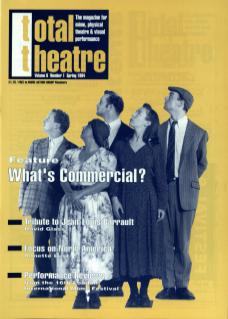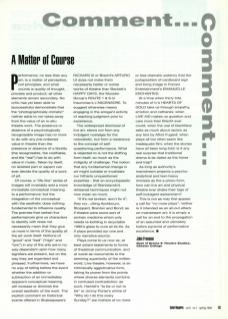Performance, no less than any art, is a matter of perception, not principles, and what counts is quality of thought, process and product; all other elements remain secondary. No critic has yet been able to (successfully) demonstrate that the ‘photographically mimetic’ neither adds to nor takes away from the value of an in-situ theatre work. The presence or absence of a psychologically recognisable image has no more to do with any pre-ordained value in theatre than the presence or absence of a libretto (the recognisable, the codifiable, and the ‘real’) has to do with value in music. Taken by itself, no isolated part or aspect can ever decide the quality of a work of art.
Of course, a ‘life-like’ series of images will invariably add a more immediate conceptual meaning to a performance; but the integration of the conceptual with the aesthetic does nothing fundamental to influence quality. The premise that certain live performances give us characters to identify with does not necessarily mean that they give us more in terms of the quality of the artwork itself. Notions of ‘good’ and ‘bad’ (‘high’ and ‘low’) in any of the arts are in no way dependent upon how many signifiers are present, but on the way they are organised and phrased. Furthermore, we have no way of telling before the event whether the addition or subtraction of an immediately apparent conceptual meaning will increase or diminish the overall aesthetic of the work. The explicit comment on historical events offered in Shakespeare's Richard III or Brecht's Arturo Ui does not make them necessarily better or worse works of theatre than Beckett's Happy Days, the Wooster Group's Route1 & 9, or Insomniac's L'Ascensore. To suggest otherwise means engaging in the arrogant activity of reaching judgment prior to experience.
The widespread dismissal of live art, stems not from any indulgent nostalgia for the naturalistic, but from a resistance to the concept of self-questioning performance. What is objected to is not the shifting form itself, so much as the indignity of challenge. The notion that any fundamental change in art might out-date or invalidate our hitherto unquestioned expertise – that an encyclopaedic knowledge of Stanislavski's rehearsal techniques might not now mean so much.
‘If it's not broken, don't fix it’, they cry, citing Ayckbourn, Stoppard, Brenton and Bond; as if theatre were some sort of archaic medicine which only needs re-bottling in recyclable 1990s glass to cure all its ills. As if plays provided our one and only narrative source.
Plays come to us now as, at best, extant testaments to forms of theatrical communication, and at worst as monuments to the seeming superiority of the written word. Live theatre, however, is an intrinsically agglutinative form, taking its power from the points where diverse elements combine in confused contradiction: as such, Hamlet's ‘to be or not to be’ or Jimmy Porter's whine of ‘Why do I do this every Sunday?’ are matters of no more or less dramatic potency that the juxtaposition of cardboard sign and living image in Forced Entertainment's Emanuelle Enchanted.
At a time when thirty trite minutes of TV's Hearts of Gold take us through empathy, emotion and catharsis; when Live Aid makes us question and care more than Brecht ever could; when the use of blackface asks as much about racism as any text by Athol Fugard; when plays all too often seem like inadequate film; when the stories have all been long-told: is it any real surprise that traditional drama is as dated as the horse and trap?
As long as authority's mainstream projects a psychoanalytical and text-heavy mimesis as the a priori form, how can live art and physical theatre ever shake their tags of self-indulgent esotericism?
This is not, as may first appear, a call for ‘no more plays’, neither is it intended as an all-out attack on mainstream art; it is simply a call for an end to the propagation of an assumed and ultimately hollow pyramid of performative excellence.
John Freeman, Dept of Drama & Theatre Studies, Chester College.

